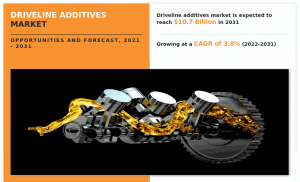Driveline Additives Market Trends: Growth, Innovations, and Future Outlook, 2031
The global driveline additives market is projected to reach $10.7 billion by 2031, growing at a CAGR of 3.8% from 2022 to 2031.
WILMINGTON, DE, UNITED STATES, August 11, 2025 /EINPresswire.com/ -- Allied Market Research published a report, titled, "Driveline Additives Market by Product Type (Transmission Fluid Additives, Gear Oil Additives, Others), by Vehicle Type (Passenger Vehicles, Commercial Vehicles, Off-highway Vehicles), by Additive Type (Dispersants, Viscosity Index Improvers, Detergents, Anti-wear Agents, Antioxidants, Corrosion Inhibitors, Friction Modifiers, Emulsifiers, Others): Global Opportunity Analysis and Industry Forecast, 2021-2031." According to the report published by Allied Market Research, the global driveline additives industry generated $7.4 billion in 2021, and is projected to reach $10.7 billion by 2031, witnessing a CAGR of 3.8% from 2022 to 2031.Request PDF Brochure: https://www.alliedmarketresearch.com/request-sample/1967
Determinants of growth-
Increase in manufacturing of automobiles around the world, rise in number of on-road and off-road motors in operation, growth in adoption of continuously variable transmission (CVT), and creation of transmissions with high operational temperatures drive the growth of the global driveline additives market. Furthermore, growth in demand for longer drain intervals from the OEMs presents new opportunities in the upcoming years.
The passenger vehicles segment to dominate by 2030-
By vehicle type, the passenger vehicles segment held the highest market share in 2021, holding around two-thirds of the global driveline additives market share, and is expected to continue its leadership status during the forecast period. Increasingly strict environmental regulations aimed at reducing greenhouse gas emissions have forced passenger car OEMs to make substantial modifications to engine hardware technology. This factor drives the segment growth. However, the off-highway vehicles segment is estimated to register the highest CAGR of 4.1% from 2022 to 2031. Urbanization in emerging economies drives the growth of the segment.
The dispersants segment to maintain the lion's share-
Based on additive type, the dispersants segment held the largest market share in 2021, holding more than one-fourth of the global driveline additives market share, and is expected to continue its leadership status during the forecast period, due to attributes such as filtration, oxidation, and others. However, the antioxidants segment is projected to register the highest CAGR of 4.8% from 2022 to 2031. This is because antioxidants happen to control oxidation, making engines run longer and more smoothly by preventing oil thickening.
Interested in Procuring This Report? Visit Here: https://www.alliedmarketresearch.com/driveline-additives-market/purchase-options
Asia-Pacific garnered the major share in 2020-
Based on region, Asia-Pacific contributed the highest share in terms of revenue in 2021, holding more than one-third of the global driveline additives market share, and is estimated to continue its dominant share by 2031. Moreover, the same region is projected to manifest the fastest CAGR of 4.0% during the forecast period. This is attributed to increase in population, rise in industrialization, and expansion of the automotive industry across the province.
Key Players in the Industry-
AB Petrochem Pvt. Ltd.
BASF SE
BRB International B.V.
Chevron Oronite Company, LLC.
Afton Chemical Corporation
The Lubrizol Corporation
Vanderbilt Chemicals, LLC.
VPS Lubricants
Evonik Industries AG
International Petroleum & Additives Company, Inc.
Access Full Summary Report: https://www.alliedmarketresearch.com/request-sample/1967
For More Details: https://www.prnewswire.com/news-releases/driveline-additives-market-to-garner-10-7-billion-globally-by-2030-at-3-8-cagr-says-allied-market-research-301561625.html
David Correa
Allied Market Research
+ + + 1 800-792-5285
email us here
Visit us on social media:
LinkedIn
Facebook
YouTube
X
Legal Disclaimer:
EIN Presswire provides this news content "as is" without warranty of any kind. We do not accept any responsibility or liability for the accuracy, content, images, videos, licenses, completeness, legality, or reliability of the information contained in this article. If you have any complaints or copyright issues related to this article, kindly contact the author above.
Former FEMA Director Craig Fugate to Join World Cares Center’s 9/10 Emergency Management Panel
Colorado Native Dr. Joshua Mares Joins the Colorado Advanced Orthopedics Team
EmberOT Unveils Free OT PCAP Analyzer v2.0 Update
Więcej ważnych informacji
 Jedynka Newserii
Jedynka Newserii

 Jedynka Newserii
Jedynka Newserii

Finanse

K. Gawkowski: Polska w cyfrowej transformacji gospodarki awansowała do pierwszej ligi w Europie. 2,8 mld zł z KPO jeszcze ten proces przyspieszy
Uruchomiony na początku lipca przez Ministerstwo Cyfryzacji i BGK program „KPO: Pożyczka na cyfryzację” cieszy się dużym zainteresowaniem. Samorządy, uczelnie oraz firmy mogą wnioskować o wsparcie finansowe dla inwestycji w transformację cyfrową, m.in. modernizację infrastruktury czy cyberbezpieczeństwo. W sumie na ten cel trafi 2,8 mld zł (650 mln euro). Ze względu na krótki czas naboru obie instytucje organizują w poszczególnych województwach warsztaty dla wnioskodawców, które mają rozwiać ich wątpliwości przy przygotowywaniu wniosków.
Prawo
Koszty certyfikacji wyrobów medycznych sięgają milionów euro. Pacjenci mogą stracić dostęp do wyrobów ratujących życie

Od 2027 roku wszystkie firmy produkujące wyroby medyczne w Unii Europejskiej będą musiały posiadać certyfikat zgodności z rozporządzeniem MDR (Medical Devices Regulation). Nowe przepisy wprowadzają dużo ostrzejsze wymagania w zakresie dokumentacji, badań klinicznych oraz procedur certyfikacyjnych. Branża ostrzega, że część małych i średnich producentów nie zdąży się dostosować. Problemem jest także wysoki koszt i długi czas uzyskiwania certyfikatów. W konsekwencji z rynku mogą zniknąć urządzenia ratujące życie.
Infrastruktura
Nowe przepisy o ochronie ludności cywilnej wprowadzają obowiązkowe elastyczne zbiorniki na wodę. Mają one służyć w razie suszy, pożarów czy wybuchu wojny

Samorządy będą musiały posiadać m.in. elastyczne zbiorniki na wodę pitną i przenośne magazyny wody przeciwpożarowej. To element odpowiedniego przygotowania zasobów na wypadek sytuacji kryzysowych, kataklizmów czy wybuchu konfliktu, wprowadzony nowymi przepisami o ochronie ludności. Eksperci podkreślają, że tego typu rozwiązania to innowacyjne produkty, które nie tylko ułatwiają logistykę w sytuacjach kryzysowych, ale także mogą znacząco skrócić czas reakcji służb ratunkowych.
Partner serwisu
Szkolenia

Akademia Newserii
Akademia Newserii to projekt, w ramach którego najlepsi polscy dziennikarze biznesowi, giełdowi oraz lifestylowi, a także szkoleniowcy z wieloletnim doświadczeniem dzielą się swoją wiedzą nt. pracy z mediami.








.gif)

 |
| |
| |
|